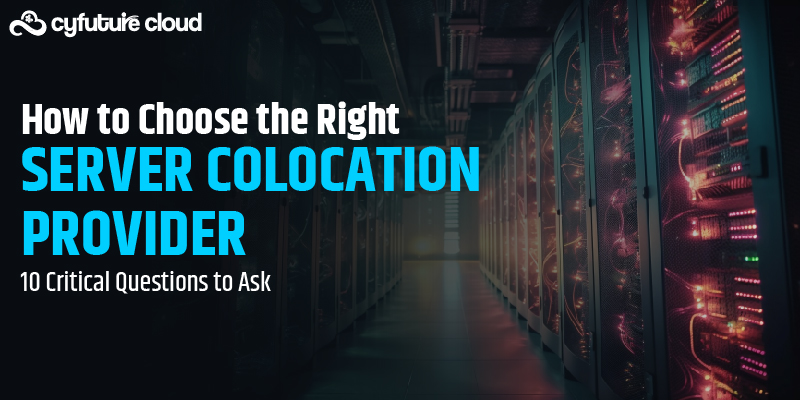Get 69% Off on Cloud Hosting : Claim Your Offer Now!
- Products
-
Compute
Compute
- Predefined TemplatesChoose from a library of predefined templates to deploy virtual machines!
- Custom TemplatesUse Cyfuture Cloud custom templates to create new VMs in a cloud computing environment
- Spot Machines/ Machines on Flex ModelAffordable compute instances suitable for batch jobs and fault-tolerant workloads.
- Shielded ComputingProtect enterprise workloads from threats like remote attacks, privilege escalation, and malicious insiders with Shielded Computing
- GPU CloudGet access to graphics processing units (GPUs) through a Cyfuture cloud infrastructure
- vAppsHost applications and services, or create a test or development environment with Cyfuture Cloud vApps, powered by VMware
- Serverless ComputingNo need to worry about provisioning or managing servers, switch to Serverless Computing with Cyfuture Cloud
- HPCHigh-Performance Computing
- BaremetalBare metal refers to a type of cloud computing service that provides access to dedicated physical servers, rather than virtualized servers.
-
Storage
Storage
- Standard StorageGet access to low-latency access to data and a high level of reliability with Cyfuture Cloud standard storage service
- Nearline StorageStore data at a lower cost without compromising on the level of availability with Nearline
- Coldline StorageStore infrequently used data at low cost with Cyfuture Cloud coldline storage
- Archival StorageStore data in a long-term, durable manner with Cyfuture Cloud archival storage service
-
Database
Database
- MS SQLStore and manage a wide range of applications with Cyfuture Cloud MS SQL
- MariaDBStore and manage data with the cloud with enhanced speed and reliability
- MongoDBNow, store and manage large amounts of data in the cloud with Cyfuture Cloud MongoDB
- Redis CacheStore and retrieve large amounts of data quickly with Cyfuture Cloud Redis Cache
-
Automation
Automation
-
Containers
Containers
- KubernetesNow deploy and manage your applications more efficiently and effectively with the Cyfuture Cloud Kubernetes service
- MicroservicesDesign a cloud application that is multilingual, easily scalable, easy to maintain and deploy, highly available, and minimizes failures using Cyfuture Cloud microservices
-
Operations
Operations
- Real-time Monitoring & Logging ServicesMonitor & track the performance of your applications with real-time monitoring & logging services offered by Cyfuture Cloud
- Infra-maintenance & OptimizationEnsure that your organization is functioning properly with Cyfuture Cloud
- Application Performance ServiceOptimize the performance of your applications over cloud with us
- Database Performance ServiceOptimize the performance of databases over the cloud with us
- Security Managed ServiceProtect your systems and data from security threats with us!
- Back-up As a ServiceStore and manage backups of data in the cloud with Cyfuture Cloud Backup as a Service
- Data Back-up & RestoreStore and manage backups of your data in the cloud with us
- Remote Back-upStore and manage backups in the cloud with remote backup service with Cyfuture Cloud
- Disaster RecoveryStore copies of your data and applications in the cloud and use them to recover in the event of a disaster with the disaster recovery service offered by us
-
Networking
Networking
- Load BalancerEnsure that applications deployed across cloud environments are available, secure, and responsive with an easy, modern approach to load balancing
- Virtual Data CenterNo need to build and maintain a physical data center. It’s time for the virtual data center
- Private LinkPrivate Link is a service offered by Cyfuture Cloud that enables businesses to securely connect their on-premises network to Cyfuture Cloud's network over a private network connection
- Private CircuitGain a high level of security and privacy with private circuits
- VPN GatewaySecurely connect your on-premises network to our network over the internet with VPN Gateway
- CDNGet high availability and performance by distributing the service spatially relative to end users with CDN
-
Media
-
Analytics
Analytics
-
Security
Security
-
Network Firewall
- DNATTranslate destination IP address when connecting from public IP address to a private IP address with DNAT
- SNATWith SNAT, allow traffic from a private network to go to the internet
- WAFProtect your applications from any malicious activity with Cyfuture Cloud WAF service
- DDoSSave your organization from DoSS attacks with Cyfuture Cloud
- IPS/ IDSMonitor and prevent your cloud-based network & infrastructure with IPS/ IDS service by Cyfuture Cloud
- Anti-Virus & Anti-MalwareProtect your cloud-based network & infrastructure with antivirus and antimalware services by Cyfuture Cloud
- Threat EmulationTest the effectiveness of cloud security system with Cyfuture Cloud threat emulation service
- SIEM & SOARMonitor and respond to security threats with SIEM & SOAR services offered by Cyfuture Cloud
- Multi-Factor AuthenticationNow provide an additional layer of security to prevent unauthorized users from accessing your cloud account, even when the password has been stolen!
- SSLSecure data transmission over web browsers with SSL service offered by Cyfuture Cloud
- Threat Detection/ Zero DayThreat detection and zero-day protection are security features that are offered by Cyfuture Cloud as a part of its security offerings
- Vulnerability AssesmentIdentify and analyze vulnerabilities and weaknesses with the Vulnerability Assessment service offered by Cyfuture Cloud
- Penetration TestingIdentify and analyze vulnerabilities and weaknesses with the Penetration Testing service offered by Cyfuture Cloud
- Cloud Key ManagementSecure storage, management, and use of cryptographic keys within a cloud environment with Cloud Key Management
- Cloud Security Posture Management serviceWith Cyfuture Cloud, you get continuous cloud security improvements and adaptations to reduce the chances of successful attacks
- Managed HSMProtect sensitive data and meet regulatory requirements for secure data storage and processing.
- Zero TrustEnsure complete security of network connections and devices over the cloud with Zero Trust Service
- IdentityManage and control access to their network resources and applications for your business with Identity service by Cyfuture Cloud
-
-
Compute
- Solutions
-
Solutions
Solutions
-
 Cloud
Hosting
Cloud
Hosting
-
 VPS
Hosting
VPS
Hosting
-
GPU Cloud
-
 Dedicated
Server
Dedicated
Server
-
 Server
Colocation
Server
Colocation
-
 Backup as a Service
Backup as a Service
-
 CDN
Network
CDN
Network
-
 Window
Cloud Hosting
Window
Cloud Hosting
-
 Linux
Cloud Hosting
Linux
Cloud Hosting
-
Managed Cloud Service
-
Storage as a Service
-
 VMware
Public Cloud
VMware
Public Cloud
-
 Multi-Cloud
Hosting
Multi-Cloud
Hosting
-
 Cloud
Server Hosting
Cloud
Server Hosting
-
 Bare
Metal Server
Bare
Metal Server
-
 Virtual
Machine
Virtual
Machine
-
 Magento
Hosting
Magento
Hosting
-
Remote Backup
-
 DevOps
DevOps
-
 Kubernetes
Kubernetes
-
 Cloud
Storage
Cloud
Storage
-
NVMe Hosting
-
 DR
as s Service
DR
as s Service
-
-
Solutions
- Marketplace
- Pricing
- Resources
- Resources
-
By Product
Use Cases
-
By Industry
- Company
-
Company
Company
-
Company
Illustrating Thoughts on the Cloud VM Hosting
Table of Contents
The term cloud hosting has become very well known in the cloud hosting industry. A virtual space utilizes to store information and cloud hosting solutions. An ever-increasing number of individuals are picking cloud-based hosting services nowadays. In this article, we will address a few worries concerning cloud-based hosting administrations.
Settling on the best decision with regards to cloud VM hosting for your sites is vital to the progress of your business. It can have enduring consequences for your sites and decide if it will be a triumph or a disappointment. An ideal cloud hosting arrangement will give high-velocity execution to your site and will ultimately have a decent effect on your clients. Cloud hosting runs on the hypervisor that uses the hypervisor to create and run different virtual machines. So what exactly is the “Cloud Hypervisor”.
What is a Cloud Hypervisor?
A Cloud Hypervisor is programming that empowers the sharing of cloud providers’ physical register and storage assets across numerous virtual machines (VMs). Made for centralized server PCs during the 1960s, hypervisors acquired wide fame with the presentation of VMware for industry-standard servers during the 1990s, empowering a solitary actual server to freely run different visitor VMs each with their working frameworks (OSs) that are sensibly isolated from one another. Thusly, issues or crashes in a single visitor VM don’t influence the other visitor VMs, OSs, or the applications running on them.
Even though there are numerous kinds of VMs, they all play out a similar assignment, empowering a solitary arrangement of actual server equipment (counting CPU, memory, stockpiling, and peripherals) and empowering the synchronous use by various occurrences of OSs, whether Windows, Linux or both.
For what reason is a Cloud Hypervisor significant?
Similarly, as hypervisors make it conceivable to acquire another degree of PC use, a Cloud Hypervisor is the supporting of all distributed computing contributions, empowering VMs and compartments to run one next to the other on a solitary server, whether those VMs have a place with a solitary client or various clients of the cloud supplier. This multitenancy controls the financial aspects of most distributed computing contributions.
Hypervisors and the VMs they support give the transportability that empowers jobs to effortlessly be relocated between cloud suppliers and on-premises servers. This empowers associations to quickly scale from on-premises servers to cloud suppliers or to add more examples of utilizations previously running in the cloud when spikes sought after happen.
Cloud Hypervisors assist with obfuscating suppliers decrease the number of room servers utilized while lessening how much energy is expected to power and cool the huge range of servers under their administration.
The Need For A Virtualization Management Tool
Today, most enterprises use hypervisors to improve on the server the executives, and it’s the foundation of all cloud administrations. While virtualization has its advantages, IT groups are frequently unprepared to deal with an intricate environment of hypervisors from various merchants. It’s not generally simple to monitor various makes of hypervisors and precisely screen the presentation of VMs. Additionally, the simplicity of provisioning expands the number of uses and working frameworks, which further increments routine upkeep, cloud security, and consistency trouble.
Additionally, VMs might in any case require IT support concerning provisioning, de-provisioning, and evaluating as per changing security and consistency commands. Investigating frequently includes skimming through various item support pages. As associations increase, the absence of admittance to legitimate documentation and specialized help can make execution and the board of hypervisors troublesome. At last, controlling virtual machine spread turns into a huge test.
Various gatherings inside an association frequently send similar jobs over various mists. This increments failure and convolutes information on the board. IT executives need to utilize the virtualization of the board apparatuses to settle the above challenges and deal with their assets productively.
Virtualization of the board instruments gives an all-encompassing perspective on all VMs, their states (running, halted, and so forth), and the accessibility of host servers. These apparatuses additionally help in performing essential upkeep, provisioning, de-provisioning, and relocation of VMs.
Benefits of Hypervisor
Hypervisors offer basic advantages for private ventures, enormous associations and individual clients the same. These include:
Reliability
A vital benefit of running VMs is that assuming one comes up short, other VMs. The actual equipment and the working framework will not impact.
Data Replication
Hypervisors work on the assignment of cloning and recreating VMs, which can request huge measures of extra room. With a hypervisor-based replication approach, you can pick the VMs and assets that should be reproduced. It saves extra room and makes the cycle considerably savvier.
Hardware Neutral
Hypervisor-based replication is hardware neutral, and that implies information copies can be handily put away on any gadget.
Server Consolidation
Hypervisors give worked in graphical dashboards that proposition upgraded visibility of the virtualized climate. This guarantees focal union and the executives of servers, regardless of whether they’re running in various working frameworks.
Desktop Virtualization
Hypervisors work with effective desktop virtualization. Empowering a virtual desktop to host on a server and recreated on a client’s actual desktop. This permits clients to get to their gadgets remotely through client gadgets. Empowering them to work at whatever point and any place they need to.
Hypervisor Security
Hypervisors make an additional layer between the working framework and assets that get to or downloads from the Internet. Regardless of whether an asset was to make issues inside a VM. The essential host and working framework would stay safeguarded by the hypervisor.
However, on the off chance that a programmer acquired unapproved admittance to a hypervisor or its administration programming. They could get to each VM the hypervisor controls and the information inside them. To forestall this, hypervisor security safeguards against interruptions all through the turn of events and execution stages and during provisioning. The executives and de-provisioning of the hypervisor.
Hypervisor security incorporates the utilization of organization security and checking apparatuses, setting suitable access honours. Take more time to limit the assault surface, and keep the hypervisor revived and fix. This helps IT administrators screen their current circumstances constantly and quickly recognize the strange or surprising ways of behaving.
Conclusion
Whenever you accomplish virtualization, it brings a combination of various assets. This will in general lessen costs and further develops reasonability. Notwithstanding it, a hypervisor can oversee expanded jobs. In a circumstance when a particular equipment hub overheats. You can undoubtedly switch those virtual machines onto a few other actual hubs. Virtualization likewise conveys different advantages of safety, investigating and backing.
Recent Post

Stay Ahead of the Curve.
Join the Cloud Movement, today!
© Cyfuture, All rights reserved.
Send this to a friend

 Pricing
Calculator
Pricing
Calculator
 Power
Power
 Utilities
Utilities VMware
Private Cloud
VMware
Private Cloud VMware
on AWS
VMware
on AWS VMware
on Azure
VMware
on Azure Service
Level Agreement
Service
Level Agreement 


















